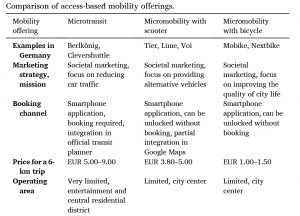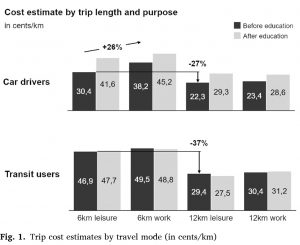Researchers Philip Fitschen an Sven Henkel, from EBS University, Germany, Katrin Merfeld, from Utrecht University School of Economics, Germany, and Jan F. Klein, from the IESEG School of Management, France published an article on Transport Policy in 2024 regarding the urban mobility challenge. The article provides an up-to-date review of this issue. Here are some key issues.
Mitigating urban car traffic is a global policy objective aimed at minimizing congestion, pollution, and accidents. A vital element in achieving this objective is the role of shared mobility providers offering sustainable alternative travel modes such as micro mobility, car sharing, or ride hailing. However, shared mobility solutions often fail to attract car users, the group that most urgently must change their travel mode choice for sustainable transport policies to be effective.
A key driver of travel mode choices is trip costs. Despite the objective cost advantage of shared mobility solutions, creating cost-based incentives for car users to switch from personal cars to more sustainable shared mobility offers is challenging.

One reason is that travel mode cost estimation is subjective, complex and lacks comparability. For example, when estimating costs, car drivers subjectively decide whether they account for vehicle depreciation, insurance, or parking in addition to fuel and maintenance costs.
The study points out that differences in perceived cost structures between cars and mobility alternatives can lead to a distorted mental image of the operating cost of cars, limiting the substitution potential for car trips.
Explaining travel mode choice through mental accounting
In addition to economic drivers, a psychological perspective is emphasized: consumers seek to reduce the financial burdens of ownership when deciding between car ownership and shared mobility. Thus, economic drivers and perceived ownership costs emerge as key factors in the decision to adopt shared mobility solutions.
The researchers argue that infrequent, substantial payments from the “car ownership” account create a distorted mental image of car operating costs, especially compared with the visible costs of shared mobility offerings.
Consequently, car drivers underestimate their travel costs without immediate education about those costs. In contrast, shared mobility providers confront users with the exact travel cost for each trip.
These effects likely manifest in different cost estimates depending on trip characteristics. Rationally, consumers should not perceive varying costs for driving a kilometer based on trip purpose or length. However, considering mental accounting effects, trip purpose and length might lead to cost estimates being allocated to different accounts.
Mission and Marketing Strategy
The user experience of shared mobility differs significantly from both car and transit, especially in the pre-usage stage. This difference is more pronounced for car users, who must make multiple digital interactions and conscious decisions not required in car travel.
Thus, the authors stress that the usage barriers for shared mobility are generally greater for car users than for transit users.
While shared mobility services align well with leisure trips for transit users, they are poorly suited for car users in all cases, except when the cost-parity group is commuting for work.
Conversely, shared mobility options are more attractive for short trips by transit users, where costs are competitive and barriers to use are minimal.
Implications for transport policymakers and shared mobility providers
The study indicates several recommendations for transport policymakers and shared mobility providers to improve the acceptance of shared mobility solutions by car users, thereby reducing car traffic and addressing the urban mobility challenge.
1) Increasing the Focus on Work Trips. Considering the higher cost perceptions of work trips and greater conscious effort involved in deciding on a travel mode for commuting purposes, the researchers suggest that shared mobility providers should aim to serve commuters. Furthermore, as work trips are the most common purpose for traveling, such efforts would substantially expand their addressed market. This focus requires a change in the providers’ operating models, as residential areas and commuting destinations must be served and the service quality must be sufficiently high (e.g., predictable availability during peak hours, us ability in inclement weather). Shared mobility providers could increase the attractiveness of commuting trips through targeted communication or cooperation with large employers and educators.

2) Reducing the Gap in Cost Perception. The authors propose three strategies to make shared mobility of fairings appear more financially competitive.
a) Mobility providers could expand their offers with degressive components covering both distance and total usage to better align with perceived costs (e.g., package subscriptions, partial ownership models).
b) Policymakers should reduce the regressive nature of car usage costs by coupling taxes, fees, and operating costs with actual use instead of ownership. Research in Singapore shows that increasing fixed costs leads to overcompensation and increased vehicle kilometers traveled.
Alternatively, increasing subsidies for non-car transportation modes might be a more feasible approach for policymakers.
c) Educating car users on the true operating costs of cars is promising owing to the structural underestimation of driving costs. For example, requiring insurers or car dealerships to provide full cost calculations (like fuel consumption and emission labels) could increase cost awareness and thus help to encourage the use of shared mobility services.
This strategy necessitates offering competitive travel prices as a foundation while minimizing usage barriers along the customer journey, particularly during the pre-usage.
